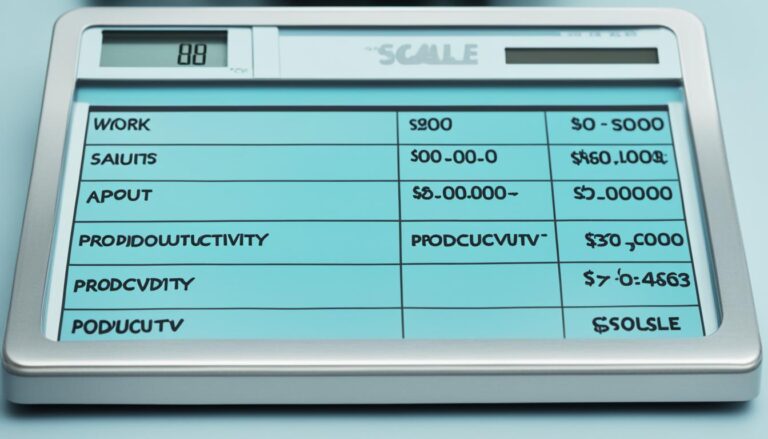Boost Your Engineering Productivity Today!

Are you looking to increase productivity in engineering? Do you want to streamline your processes and optimize your workflow? Discover the key to efficiency in engineering and take your productivity to new heights.
Engineering productivity is crucial for success in the software development industry. It not only allows you to deliver new features faster but also enables you to experiment with different processes, techniques, and tools to continuously improve efficiency.
But how do you measure and improve engineering productivity effectively? What are the essential metrics and techniques that can make a significant impact on your team’s performance?
In this article, we will delve into the importance of measuring engineering productivity and explore the strategies and techniques that can help you increase efficiency and output. Get ready to unleash your team’s full potential and achieve remarkable results.
Key Takeaways:
- Measuring engineering productivity is vital for identifying bottlenecks and improving workflows.
- Tracking key metrics allows you to remove inefficiencies and increase efficiency without compromising on quality.
- Establishing a baseline and focusing on the right productivity metrics guide continuous improvement.
- Avoid common mistakes when measuring productivity to get a holistic view of your team’s performance.
- Implement productivity techniques such as delegating tasks, utilizing technology, minimizing distractions, asking questions, and taking breaks to optimize performance.
Why Is Measuring Engineering Productivity Important?
Measuring engineering productivity is crucial for organizations aiming to optimize their software development process and achieve better outcomes. By tracking essential productivity metrics in software engineering, companies can enhance their delivery of new software and features, improve their financial performance, and avoid accumulating technical debt. Through the identification and elimination of bottlenecks, workflow improvements, and increased efficiency, measuring engineering productivity ensures that work is conducted proficiently and maintains a high standard of quality. With a focus on productivity metrics, organizations can increase their output without compromising on the quality of their software.

How Does Engineering Productivity Work?
Engineering productivity is a crucial aspect of optimizing the software engineering process and enhancing overall efficiency. It involves measuring data and utilizing important metrics to gain valuable insights into team performance. By establishing a baseline of how the engineering organization is functioning and comparing metrics with top engineering organizations, areas for improvement can be identified and targeted.
When it comes to measuring engineering productivity, it is essential to focus on the right productivity metrics that provide meaningful data on productivity and guide teams towards continuous improvement. These metrics serve as valuable indicators of team performance and efficiency, offering actionable insights for process enhancement.
Some key engineering productivity metrics that are worth considering include:
- Merge frequency: This metric measures how often code changes are merged into the main codebase. A higher merge frequency indicates a more agile and efficient development process.
- Cycle time: Cycle time refers to the time it takes for a feature or task to move from initiation to completion. Tracking cycle time helps identify bottlenecks and areas for improvement.
- Planning accuracy: This metric assesses how accurately tasks are estimated and planned. It ensures that projects are realistically scoped and deadlines are effectively managed.
- Resource allocation: Effective resource allocation involves ensuring that team members are assigned tasks according to their skills and availability. It helps optimize productivity by maximizing the utilization of available resources.

By focusing on these metrics and others relevant to your specific engineering environment, you can gain valuable insights into your team’s performance and work towards continuous improvement. Implementing strategies based on these insights will enhance productivity in engineering and contribute to overall organizational success.
How NOT to Measure Productivity in Software Engineering Teams
When measuring productivity in software engineering teams, it is crucial to avoid common mistakes that can lead to inaccurate assessments. Simply prioritizing speed without considering other factors can result in the release of low-quality software that fails to meet its intended purpose. Relying solely on individual productivity measurements may not provide a comprehensive understanding of team performance and hinder the identification of real issues within workflows and processes. Similarly, focusing on output-based metrics like lines of code does not offer meaningful insights into productivity levels.
Instead, it is essential to adopt holistic measures that provide valuable insights into the actual productivity of the team. By considering various aspects and factors, software engineering teams can gain a clearer understanding of their performance and identify areas for improvement.

One common mistake is solely relying on the speed of completing tasks to evaluate productivity. While efficiency is vital, it should not be the sole focus. In the fast-paced world of software engineering, quality is equally important. Releasing a product quickly, but with low quality, can lead to customer dissatisfaction and potentially damage the reputation of the organization.
Another mistake to avoid is measuring individual productivity as the sole indicator of team performance. Software engineering is a collaborative effort, and team dynamics heavily influence productivity. Relying solely on individual metrics can create unhealthy competition within the team and hinder the identification of systemic issues. It is crucial to assess team performance as a whole and foster a collaborative environment that encourages sharing knowledge, supporting each other, and promoting innovation.
Additionally, using output-based metrics like lines of code as a measure of productivity can be misleading. Writing more lines of code does not necessarily translate to higher productivity. It is essential to look beyond quantity and focus on metrics that gauge the quality of code, efficiency of problem-solving, and adherence to project specifications.
Ultimately, measuring productivity in software engineering teams requires a comprehensive approach that captures the multidimensional nature of the work. By considering a range of productivity metrics and focusing on the overall outcome, organizations can gain valuable insights, identify areas for improvement, and drive meaningful progress in software engineering productivity.
Conclusion
To improve engineering productivity, you need to implement effective techniques that optimize your performance and ensure better results. One crucial technique is delegating tasks to team members who have the time and expertise, allowing for improved efficiency and resource utilization.
Another essential aspect is maximizing the use of technology tools and software programs, which can streamline your workflows and enhance communication within the team. By leveraging these tools, you can eliminate unnecessary manual tasks and focus on the essential aspects of your work.
Minimizing distractions is also key to maintaining focus and productivity. By reducing activities like excessive email checking and restructuring your schedule to minimize interruptions, you can create a conducive environment for concentrated and efficient work.
Furthermore, asking questions and learning from experts in your organization is a valuable practice. This enables you to expand your skills and knowledge base, improving your performance and contributing to the overall productivity of the team.
Lastly, don’t underestimate the importance of taking breaks and engaging in social interactions. By allowing yourself time to rest and recharge, you can reduce stress levels and enhance your overall mood and satisfaction, resulting in increased productivity.
By incorporating these productivity techniques into your engineering workflow, you can enhance your team’s efficiency, optimize your performance, and achieve remarkable results.
FAQ
How can I boost engineering productivity?
To boost engineering productivity, you can delegate tasks, maximize the use of technology, minimize distractions, ask questions, and take breaks.
Why is measuring engineering productivity important?
Measuring engineering productivity is important because it helps identify bottlenecks, improve workflows, and increase the quality and speed of software production.
How does engineering productivity work?
Engineering productivity works by measuring data and using important metrics to gain insights into team performance, comparing metrics with top engineering organizations, and focusing on the right productivity metrics for continuous improvement.
How NOT to measure productivity in software engineering teams?
It is important to avoid focusing solely on speed or individual productivity. Output-based metrics like lines of code do not provide meaningful data on productivity. Holistic measures that give insights into the actual productivity of the team should be used instead.
What are some productivity techniques to improve engineering productivity?
Some productivity techniques to improve engineering productivity include delegating tasks, maximizing the use of technology, minimizing distractions, asking questions, and taking breaks.






